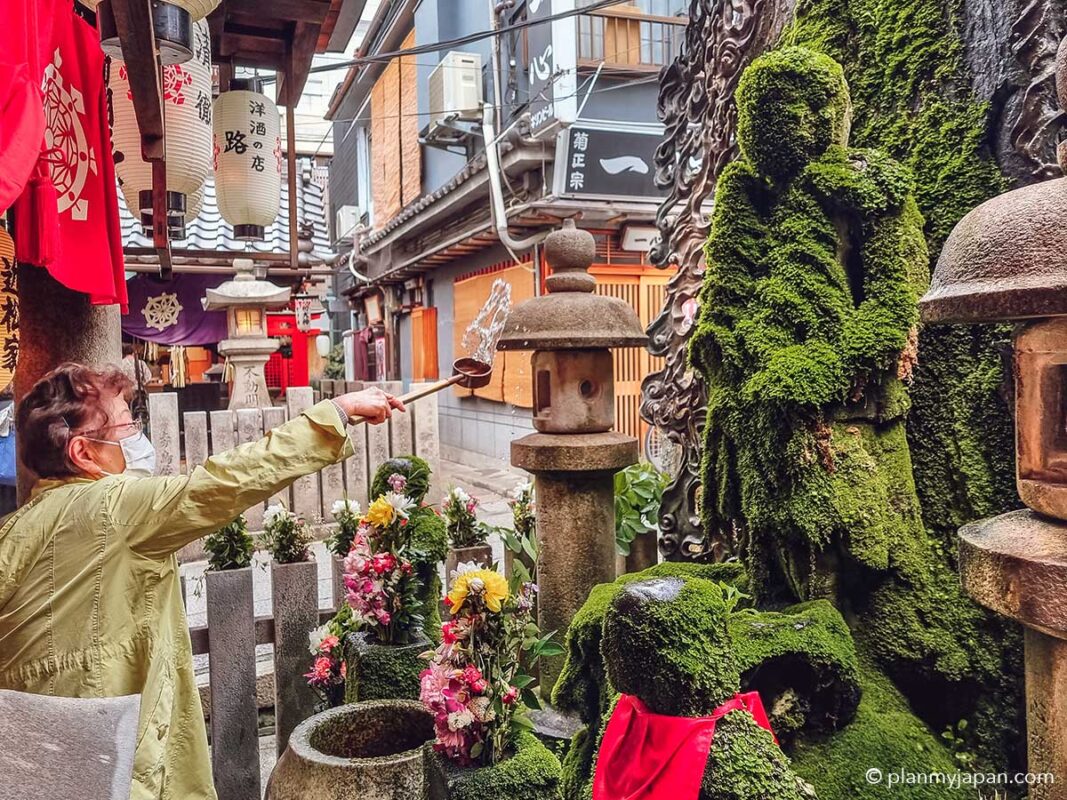This post may contain affiliate links to tours and hotels. These help us earn a small commission at no additional charge to you.
Hidden away in the backstreets of Dotonbori amongst all the okonomiyaki and izakayas, Osaka’s Hozenji Temple is perhaps best known for its moss-covered statue of the deity Fudo-myo-o.
One of the most unusual and beautiful Buddhist temples in Osaka, the tiny temple of Hozenji and its moss-like figure is an easy two minute walk from the main Tonburi river area and famous Glico Man sign.

Part of the main allure of the Hozenji Temple is not only the mossy growth over one of the statues to almost turn it into a green man but also the unlikely location.
It is literally a small temple snugly hidden down a back street (‘Yokocho’) with various overt Osaka comings and goings associated with the Dotonbori entertainment district.
From the moss-man deity to the interesting characters that visit, here is our full guide to Osaka’s Hozenji Temple:

You might like – Guide to the Don Qujiote stores in Japan (or our guide to the Don Quijote Ferris Wheel in Dotonbori Osaka). >
How to get to Hozenji Temple / Hozenji Yokocho
Located in Osaka, the Hozenji Temple and Hozenji Yokocho are just a short five minute walk away from Ebisubashi Bridge, the Glico Man sign or Kura Sushi Dotonbori.
The closest train station to Hozenji Temple and Yokocho is the Osaka-Namba station on the Hanshin – Namba Line, or the Namba Subway Station. The shrine is a 3 minute walk from both stations.

You might like – Guide to Osaka’s Namba Yasaka Shrine AKA the Lion Head shrine >
What is the Hozenji Temple?
A small shaded shrine and temple located at the foot of Hozenji Yokocho (the epicenter of back-street bars and iconic izakayas), the Hozenji Temple is a small shrine and temple complete with a water bucket where locals come to take part in Haka-mairi or hakamairi (the religious ritual cleaning of one’s hands and grave area).
Perhaps the most likely reason why the Hozenji Temple is so famous is the mossy Fudo Myo statue (of a wrathful deity) and the juxtaposition of the location – a peaceful place in the midst of chaotic scenes and busy restaurants and food vendors.

You might like – Guide to the famous running Glico Man in Dotonbori (plus a secret viewing spot) >
The Mossy Statue Statue of Hozenji Temple (Fudo Myo)
Almost like something out of a Marvel movie or horror film, the Fudo Myo statue here along with two statues either side have become covered in a green- moss or algae like substance. If you grew up watching He-Man (ヘマン), the statue looks just like He-Man’s Moss Man character.
But why is this particular Osaka temple statue so mossy?

When worshippers visit the Hozenji temple and pray to the Fudo Myo-o statue, most visitors use one of the small water buckets and splash the statue with water. Given the alleyway / Hozenji Yokocho location (which is often quite dark), it has created optimum conditions for the moss to grow (and grow and grow).
The whole effect is like a very grassy or mossy man is watching over the temple – it is kind of spooky but also quite spiritual as though the statue has become a life-form of its own.
This is definitely one of the more quirky and unusual things to do in Osaka and Dotonbori (and that is coming from someone who has ridden Osaka’s Don Quijote ferris wheel…)
Seitakadoji and Kongaradoji statues are also in place next to the main Fudo Myo-o statue.

BRAND NEW FOR MAY 2024
Join our Facebook Japan Travel Tips Group!
Need help with your Japan itinerary or have any questions?
Head on over to our Facebook group and ask the experts!
Click here to join our group >
Who is Fudo Myo-o?
The centre-piece of the Hozenji Osaka Temple, Fudo Myo-o is the main ‘Myo’ – or ‘Lord of Light / Bright King’ (of five) who drives away evil spirits (well, no small wonder if you saw all that moss coming after you…).
His name translates as “the immovable one” and Fudo Myo-o protects Buddhism and its worshippers.
Many people now make the trip to Fudo Myo-o to douse the statues (Fudo Myo-o, Seitakadoji and Kongaradoji) in water and witness this ‘mossy miracle’ with their own eyes.

You might like – Things to do in Dotonbori, Osaka >
History of Hozenji Temple in Osaka
The original Hozenji Temple is said to have been built in the 1630s in a former burial area and graveyard – this was years before it became the famous Dotonbori entertainment area so it would have been much more peaceful and quieter back then.
Sadly, most of the Hozenji Temple was devastated by air raids and bombs over the years, so most of the current Hozenji Temple dates back to the 1940s when it was destroyed and subsequently rebuilt.

You might like – the cult of TENGA shops in Japan (a very ‘stimulating’ and ‘adult’ read) >
Japanese Prayer Boards and Omikuji
The small temple and shrine to the left of the Fudo Myo-o across the cobbled path is home to lanterns and prayer plaques.
Locals and Osaka citizens use these prayer plaques to ask the deities for health, wealth and love plus success at school (kind of like manifestation).

Once completed, these colourful prayer boards are hung up all the grounds and in trees and across special boards, creating a tapestry of thoughts and prayers.
You will also sometimes see Omikuji, which are small pieces of tied paper which tell fortunes in Japan – if you receive a ‘good fortune’, you can either take it home or tie it up in the temple to increase your likelihood of good luck.
Omikuji are available to purchase in the Hozenji Temple via donation boxes.
You might like – Guide to 7-Eleven stores in Japan (or using a 7-Eleven ATM guide) >
When is the Hozenji Temple open?
Unlike some temples, there aren’t any walls or barriers around the mossy deity statues so you can visit Hozenji Temple 24 hours a day, seven days a week.
You might like – The cult of Lawson’s fried chicken karaage kun (or the special themed Lawson Dragon Quest store in Osaka) >
How much does it cost to visit the Hozenji Temple?
The Hozenji Temple is free to visit and is open 24 hours a day, 7 days a week. Donations are appreciated.
You might like – 40+ Kit Kat flavours to try in Japan >
When is the best time to visit the Hozenji Temple?
Given its popularity (especially on social media), the Namba Yasaka shrine can be very busy from mid morning until early evening.
There is often a line of people who wish to worship and splash water on the Fudo Myo-o moss statue and other deity figures.
If you can try, perhaps the best time to visit the Hozenji Temple is at night, as the alleyway (Hozen-ji Yokocho) is more atmospheric at night plus the lanterns are all lit.

After you’ve paid your respects, be sure to visit one of the nearby Hozen-ji Yokocho restaurants (there are several famous kushi katsu and okonomiyaki restaurants within a 2 minute walk of the temple).
If you visit at night, you might also see another famous Osaka local character lurking in the shadows of the temple – the Osaka Dotonbori Wolfen.
This is essentially a mystery man dressed in a wolf mask and long blue coat who helps clean the streets and also plays his melodica at night.
On our last visit to Hozenji Temple, the Dotonbori Wolfen was lurking in the background to the right of Fudo Myo-o playing with stray cats – a very surreal Osaka experience!
Read more about our Osaka Dotonbori wolfen / wolfman sightings here (with video)>


Other things to do near Hozenji Temple
Hozenji Yokocho has so much going on both day and night, from cool lunchtime eateries to epic neon-lit izakayas and kushikatsu restaurants.
Just a 30 second walk away brings you to the popular Hozenji branch of the famous Osaka kushikatsu chain, Kushikatsu Daruma – expect queues in the evening but it is a lot quieter in the day.

You might like – the cult of Japanese egg sandwiches from convenience stores >
Honke Otako Hozenji
We also discovered this incredible family-run Osaka okonomiyaki restaurant within yards of the Hozenji Temple.

Honke Otako Hozenji serves an incredible array of okonomiyaki cooked fresh in front of you on a hot griddle.
Upstairs, there are several traditional Japanese style horigotatsu tables (tables that are low to the ground and have a recessed floor beneath). Beer prices are also very good. We went there a couple of times as the okonomiyaki was so tasty!

You might like – Guide to visiting the Cup Noodles Museum in Yokohama >
Sennichimae Street
A huge covered shopping street in Osaka, Sennichimae Street is full of kitchenware stores and restaurants open all hours.

You might like – The coolest gachapon capsule toys in Japan >
Other things to know Hozenji Temple and Yokocho
- In early 2022, Osaka police arrested a man for removing the moss from the neighbouring Seitakadoji and Kongaradoji statues. He was subsequently released without charge (to note he didn’t remove the moss from Fudo Myo-o, just the two neighbouring statues).
- Paddles and religious water buckets are provided by the temples.
- Around 1644, Hozenji Temple held a special service/ prayer for 1,000 days and nights. “Sennichi” in Japanese means ‘1000 days, so this shrine is also known as Sennichi temple (千日寺).
Hozenji Temple and Yokocho Address
1 Chome-2-16 Namba, Chuo Ward, Osaka, 542 – 0076, Japan.
Did you enjoy our Hozenji Temple in Osaka blog post? Let us know in the comments or by sharing it on social media.
You can follow us on:
Instagram
Tik Tok
Facebook
Pinterest
YouTube
You might also like to read…
Namba Yasaka Shrine (Lion Head Temple) in Osaka Guide
Things to do in Dotonbori, Osaka
Everything you wanted to know about Don Quijote stores in Japan
Yokohama, Japan – Top Things To Do Guide + Photos
Snow Monkeys in Nagano, Japan – how to visit the hot spring park
Odaiba, Tokyo – Things To Do + Photos
Cult of Dragon Quest Lawson – a themed convenience store in Osaka

